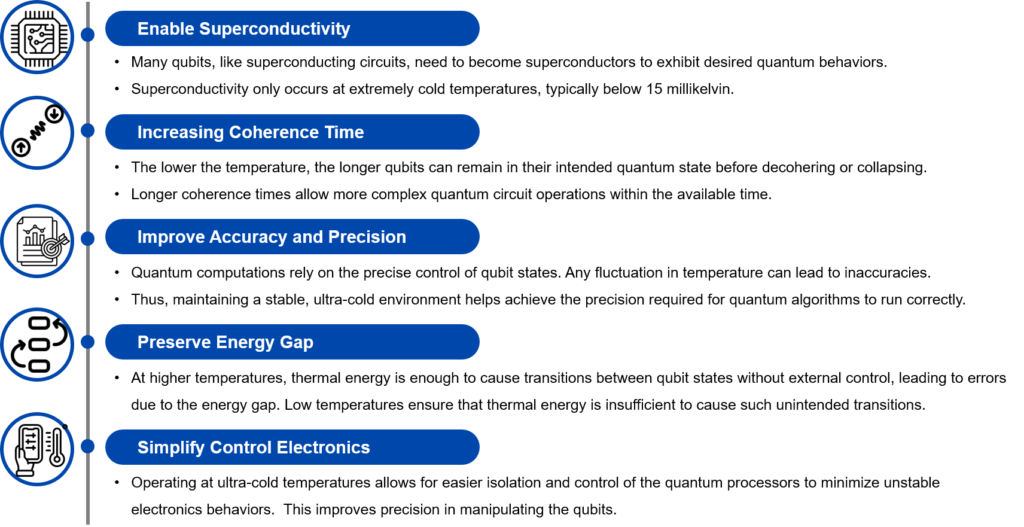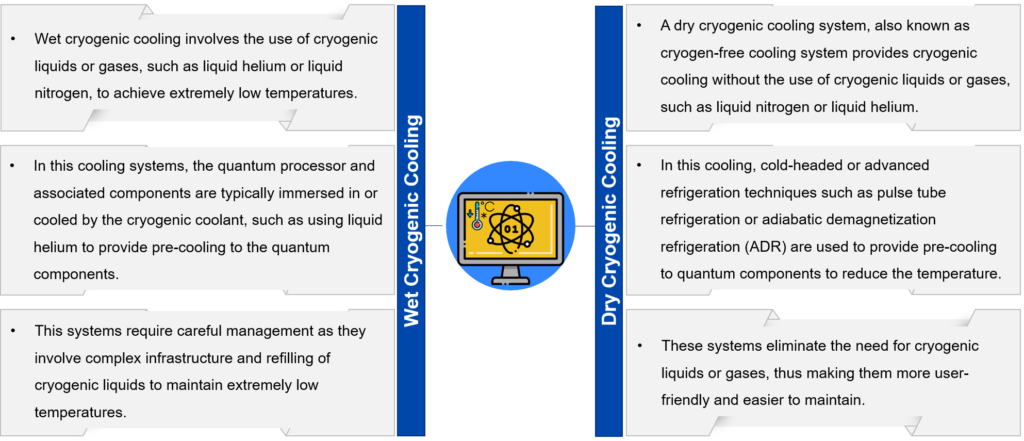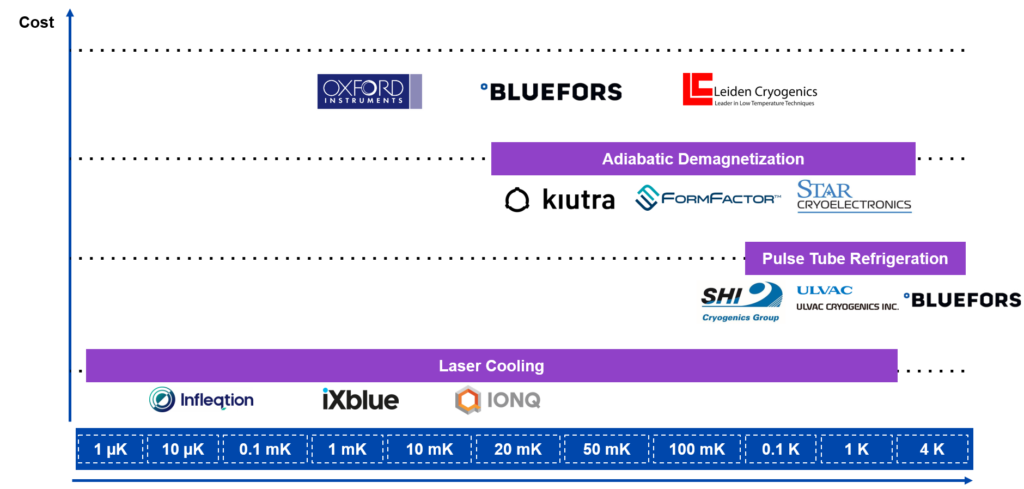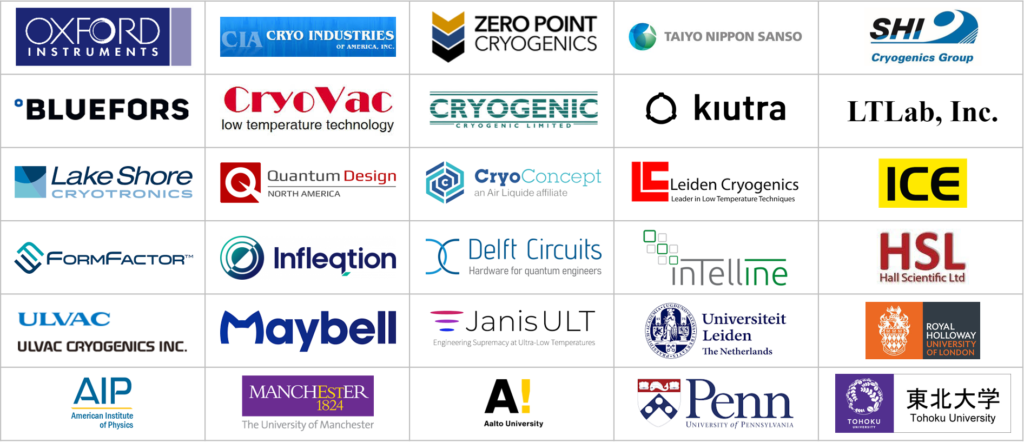Quantum computers have revolutionized computing technologies by leveraging the principles of quantum mechanics. Quantum computers can process large amounts of data and solve complex problems aggressively faster than traditional computers, which makes them essential for advancements in various domains like healthcare, finance, technology, education, and others. Unlike traditional computers that operate at room temperature, quantum computers need extremely low temperatures to operate efficiently. They must be operated around zero kelvin to ensure minimum thermal noise and environmental interference.
But how do we cool quantum computers? Let’s learn about some of the prominent cutting-edge cooling technologies or and how these advanced technologies use sophisticated methods to achieve the ultra-low temperatures required for quantum computing systems.
What is Quantum Computing?
Quantum computing is a field that utilizes fundamental physics and quantum mechanics principles to quickly calculate highly complex problems.
- It is based on quantum bits, or qubits, which store zeros and ones in the quantum chips, just like any traditional computer. It utilizes the power of subatomic particles, which have an unusual capacity to exist simultaneously in many states, such as 0 and 1, a process known as superposition.
- These qubits also interact with each other through the entanglement process to scale the data exponentially. For example, two qubits can store and process four bits of information, three can process eight, and so on. This exponential scaling provides quantum computers with significant power compared to conventional computers.
Why do Quantum Computers Need Extreme Cold or Low Temperatures?
While qubits bring promising futures by leveraging quantum effects, they also present significant challenges. Qubits are extremely delicate and prone to errors due to environmental factors like temperature and electromagnetic interference from noisy surroundings.
Many atoms surround quantum circuits, which are the building blocks for quantum computers. These atoms exhibit unique behaviors that enable long-lasting entanglement and coherence to the vibration of thermal energy on the atoms, which creates variable electric and magnetic fields. Also, the quantum circuits require a controlled environment to leverage the scalability and quantum effects, maintain the qubits in superposition for a long time, and minimize the impact of external influences. For example, maintaining scalability for large-scale quantum computers and more complex computational problems and holding qubits in superposition for a long time, known as coherence time, is a considerable challenge.
External factors such as thermal noise, vibration, or environmental interaction can cause decoherence, leading to computation errors. Moreover, extracting useful information from qubits in superposition requires specialized algorithms and quantum error correction techniques.
Apart from the above reasons, some of the other prominent reasons why quantum computers need low-temperature cooling are mentioned in Figure 1.

Figure 1: Low-temperature requirements of quantum computing
What is Cryogenic Cooling?
For quantum computers to operate effectively, they require low temperatures, typically close to absolute zero (0 Kelvin or -273.15°C). The cryogenic cooling process is used to achieve this extremely low or cryogenic temperature, which cools the quantum computers by reducing temperatures to extremely low levels using specialized techniques and equipment.
The environment created for extremely low temperatures, or cryogenic temperatures, stabilizes the quantum states by keeping the atoms frozen. This helps isolate and control the qubits, thus minimizing the electric and magnetic field fluctuations that could lead to qubits’ decoherence.
By cooling quantum processors to absolute zero, typically below 1 Kelvin, cryogenic cooling minimizes the vibrations and thermal excitations by reducing the thermal energy that causes qubits to lose their quantum information. It allows for longer coherence times and higher fidelity quantum operations, with long-lasting and more reliable quantum states.
As shown in the below figure, cryogenic cooling is basically of two types:

Figure 2: Different types of cryogenic cooling for quantum computers
What are the Various Ways or Methods of Providing Low-temperature Cooling to Quantum Computers?
As quantum systems are susceptible to the environment, cooling the qubits to extremely low temperatures becomes critical. Lowering the temperature helps suppress thermal noise or vibrations and allows qubits to maintain their quantum coherence for a long time. Figure 3 shows some of the prominent cooling technologies based on their operating temperature range for cooling qubits in quantum computing applications and their prominent key players.
Prominent cooling techniques are briefly described below:
- Dilution Refrigeration: Dilution refrigerators are one of the most common cooling methods for qubits, typically reaching temperatures close to absolute zero (around 10 mK or -273.14°C). These refrigerators use a mixture of helium isotopes such as helium-3 (³He) and helium-4 (⁴He) and a helium dilution process to achieve and maintain very low temperatures. This cooling method is suitable for superconducting qubits and some types of trapped ions. These dilution refrigerators are bulky, complex, and expensive systems that use multiple cooling stages to cool the quantum circuits.
- Adiabatic Demagnetization Refrigeration (ADR): In this low-temperature cooling technique, a magnetic substance undergoes adiabatic (heat-exchange-free) demagnetization to reduce paramagnetic material temperature. This technique can achieve temperatures below 2 K by applying a strong magnetic field to align the atomic magnetic moment, followed by its subsequent reduction. The material’s thermal energy surpasses magnetic interactions, resulting in low-temperature cooling.
- Pulse Tube Refrigeration (PTR): To achieve temperatures below 4 K, PTR uses a mechanical device to generate a high-frequency pressure wave within a sealed gas circuit or closed-cycle cryostats. This oscillating pressure wave stimulates the gas to alternate between expansion and contraction, leading to temperature fluctuations, which generate low temperatures for cooling purposes. This type of cooling technique is generally suitable for superconducting qubit implementations.
- Laser Cooling: Laser cooling is a technique that uses frequency and laser light intensity tuning to reduce the speed of the movement of atoms and other particles. When an atom traps a light photon, it gains momentum in the direction of its travel to be manipulated with greater precision. The laser cooling technique is suitable for trapped ions quantum technology modality to control the individual ions within the trap. Depending on the type of qubits used, multiple cooling methods can be utilized for specific quantum computing technology. Depending on the type of qubit technology, there may be different cooling requirements and temperature tolerances.

Figure 3: Prominent cooling techniques for cooling qubits of a quantum computer with operating temperature range and prominent key players
Futuristic Cooling Technologies of Quantum Computing
In the current scenario, the quantum computers can be cooled to ultra-low temperatures using wet cryogen and dry (cryogen-free) cooling. However, the utilization of these two cooling methods depends on various factors, such as the cooling requirement of quantum computers, including the complexity of cooling systems and parameters like the number and type of physical qubits, operating temperature, system’s packaging efficiency, energy consumption, performance requirements, cost considerations, cooling system size, and the split between circuits operating at cryogenic temperatures and those operating at room temperature.
Researchers are working on developing new techniques or systems to overcome these challenges faced by low-temperature cooling techniques. The following are the under-researched or prototype technologies that can become potential technologies in the future for achieving low-temperature quantum computer cooling.
- Immersing Quantum Circuit In Liquid He3: Researchers from the Royal Holloway University of London, Chalmers University of Technology, and Google are working on a new technology to cool down a quantum circuit to less than a thousand degrees above absolute zero, almost 100 times lower temperature than achieved before, by immersing the circuit in liquid He3. When immersed in liquid helium, the atomic-scale defects of the quantum circuit material are minimized, and excess energy is taken away. This new device thus can significantly optimize the coherence of quantum circuits.
- Wireless Technique: MIT researchers have developed a prototype of a wireless communication system, where they have developed a square transceiver chip measuring approx. 2 mm on each side is placed inside a cryostat that utilizes a passive communication process called backscatter, involving reflections, to send and receive data from a terahertz wave source outside the cryostat. This wireless communication allows a quantum computer to exchange data with external electronics outside the refrigerator without physical connections using high-speed terahertz waves. This innovative method significantly reduces heat generation, making it more energy-efficient.
- Electrical Cooling Method: VTT is developing a cooling technology based on micro-electronics and electric current and has developed a prototype known as a thermionic device that sheds heat in the form of electrons. The researchers expect that this device cooling technology will allow quantum computers to cool to extreme temperatures ranging between 1.5 K and 0.1 K. Further, this technique will be much smaller, less expensive, and less prone to errors than fluid-based cooling.
- Splitting Bose-Einstein-Condensate: At TU Wien (Vienna), researchers are working on achieving cooling by splitting the Bose-Einstein condensate into two parts, neither abruptly nor particularly slowly. This appropriate dynamic splitting is done in a very specific temporal that can suppress the number of particles’ fluctuations so that the random fluctuations are prevented as perfectly as possible. This cooling method can significantly minimize the temperature of the already extremely cold Bose-Einstein condensate to another level.
- Helium-Free Cooling Using Super Solid: The Chinese researchers are utilizing a supersolid material known as triangular-lattice cobaltate to achieve ultra-low temperatures of up to 94 mK. They are using the giant magnetocaloric effect (MCE) of spin supersolid, a quantum spin analog of supersolidity with frustrated quantum magnets, to achieve helium-free cooling below 1K temperature. This novel triangular-lattice cobaltate material changes the effect of heating or cooling magnetic material based on the changes in the magnetic fields. Thus, it exhibits the unique properties of the magnetocaloric effect (MCE).
Market Synopsis of Cooling Technologies for Quantum Computing
The immense technical challenges of cooling quantum computers to low temperatures have restricted their development to a greater level. Several companies, such as established players, academic institutions, or specialized startups, are working on cooling refrigeration systems to provide ultra-low temperatures or temperatures below 1 K, as shown in Figure 4.

Figure 4: Key players, academic institutions, and specialized startups working on cooling refrigeration systems for quantum computers
Recent Market Activities in Cooling Technologies for Quantum Computing
- In April 2024, Bluefors revealed the development of an all-in-one, ultra-compact cryogenic measurement dilution refrigeration system. The new ultra-compact LD, known as the Bluefors LD system, is a small-footprint dilution refrigerator, ideal for laboratory environments with limited space or where multiple units need to be in a single space, such as high-performance computing data centers.
- In April 2024, Rigetti Computing and Oxford Instruments announced the successful completion of their three-year project to build the first UK-based quantum computer. This is a 32-qubit quantum computer integrated with the ProteoxLX Dilution Refrigerator provided by Oxford Instruments.
- In February 2024, Fujitsu collaborated with QuTech to develop the world’s first compact cryogenic electronic circuits for controlling diamond-based quantum bits. This new technology cools or freezes all the electronics of a quantum computer instead of just the spin diamond qubits. By leveraging cryo-CMOS circuit technology, they have designed a magnetic field application circuit and a microwave driving circuit necessary for driving a diamond spin qubit at 4 Kelvin in the same cryogenic refrigerator as the qubit. This new technology simplifies wiring bottlenecks in cooling qubits and maintains high-quality performance to realize large-scale integrated quantum computers in the future.
- In October 2023, FormFactor launched the new HPD XLF-600 Cryogen-Free Dilution Refrigerator. The HPD XLF-600 is equipped with the Aspect Dilution Refrigerator (DR) core and Frostbyte™ software to provide substantial cooling capacity, extensive experimental accessibility, and cutting-edge secure software tailored to the quantum computing R&D and quantum data center requirements. The high cooling power is due to the Aspect DR core, which integrates high-efficiency heat exchangers with a consistent and resilient laser-welding manufacturing process to boast 10 mK base temperature for delivering exceptional cooling capabilities, including 600 µW at 100 mK and over 15 µW at 20 mK, setting new standards in the field.
- In September 2023, PsiQuantum partnered with the U.S. Department of Energy’s SLAC National Accelerator Laboratory to accelerate high-powered cryogenic cooling technology development and testing to support building a large-scale, error-corrected quantum computer.
Conclusion
The need for low-temperature cryogenic cooling is one major factor influencing the scalability and practicality of quantum computers. Developing more efficient and compact cryogenic systems and cooling technological solutions is an active area of research and innovation to preserve the qubit coherence and control the delicate quantum states of quantum particles at low temperatures, with potential implications for the accessibility and commercialization of quantum computing technologies. Innovations are consistently going on in this field to enable reliable qubit control, error correction, and scalability. Researchers are constantly working to overcome the cryogenic challenges to improve efficiency and accuracy and discover horizons of quantum technologies such as quantum sensors, quantum optics setups, and quantum computers, as well as other application areas such as materials science, cryptography, and beyond.